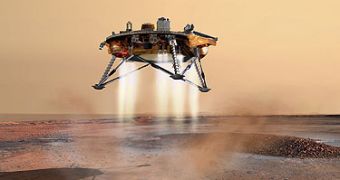The Phoenix, a fabulous mythical bird the size of an eagle, symbolizes rebirth in many ancient cultures. According to the ancient Greeks, the bird lives in Arabia, nearby a coolwell and sings a beautiful morning song. The phoenix lives 500 years or longer with only one phoenix existing at a time. When the bird's death approaches, it bursts into flames, and a new bird springs from the consumed ashes.
Scientists are gearing up for the next Mars attack with the new Phoenix mission, the first in a low-cost series of probes aimed at the Red Planet over the next decade.
An army of robots currently is orbiting and crawling over Mars, including Spirit and Opportunity, the two successful rovers that refuse to die more than three years after their arrival. But Phoenix will do something they can't: dig for ice.
There is a general opinion among scientists, that Mars once mirrored Earth, with rivers flowing with water. Five years ago, NASA's Mars Odyssey orbiter found evidence of "ice-rich soil near the surface in the arctic regions", so if frozen water lurks under the surface, scientists will need a high-tech shovel.
Phoenix will use some of the most sophisticated and advanced technology ever sent to Mars. A robust robotic arm built by JPL will dig through the soil to the water ice layer underneath, and will deliver soil and ice samples to the mission's experiments. On the deck, miniature ovens and a mass spectrometer, built by the University of Arizona and University of Texas-Dallas, will provide chemical analysis of trace matter.
A chemistry lab-in-a-box, assembled by JPL, will characterize the soil and ice chemistry. Samples will be heated in a small oven, where sensitive instruments will study their composition and look for organics - the stuff of life.
Imaging systems, designed by the University of Arizona, University of Neuchatel (Switzerland) (providing an atomic force microscope), Max Planck Institute (Germany) and Malin Space Science Systems, will provide an unprecedented view of Mars - spanning 12 powers of 10 in scale.
The Canadian Space Agency will deliver a meteorological station, marking the first significant involvement of Canada in a mission to Mars.
The $386 million Phoenix is scheduled to blast off from Florida in August. After arriving at Mars next year, it will enter the atmosphere inside a heat shield, separate and, using the thrust of 12 descent engines, it will make a powered soft landing at the north pole.

 14 DAY TRIAL //
14 DAY TRIAL //